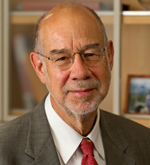October 7, 2013 - By Kris Newby

Harry Greenberg
A Stanford center focused on accelerating the translation of medical research from bench to bedside will receive $45.3 million over four and a half years from the National Institutes of Health.
The Stanford Center for Clinical and Translational Research and Education, also known as Spectrum, is among 15 institutions to receive Clinical and Translational Science Awards from the NIH. Spectrum earned the top peer-review score on its proposal for the new funding. The dollar amount is 70 percent more, on an annual basis, than that of its previous Clinical and Translational Science Award.
"The award is a strong vote of confidence for our work in translational discovery," said Lloyd Minor, MD, dean of the School of Medicine. "This new funding will help fuel the efforts of our physicians and scientists working to translate medical discoveries into better patient care and to train the medical innovators of tomorrow."
Spectrum's director, Harry Greenberg, MD, said he is pleased with the award in light of recent cutbacks in government-funded research. "We're facing major paradigm shifts in medicine, and I believe that the CTSA funding will make an enormous difference in addressing what is certainly one of our nation's biggest challenges: providing better, safer and less costly health care to our entire population," said Greenberg, who is also senior associate dean for research at the medical school and professor of medicine and of microbiology and immunology.
This new award marks Stanford's sixth year as a member of the CTSA consortium, a group of 60-plus institutions working together to improve human health through innovations in clinical and translational research and education.
The NIH launched the CTSA program in 2006 to help meet the nation's urgent need to provide better health care to more people for less money. This motivated the NIH to incentivize research institutions to more rapidly move breakthroughs in basic research to breakthroughs in patient care.
The CTSA program tackles this problem on three fronts: It catalyzes innovation by encouraging collaborations across departments and institutions; it underwrites the modernization and streamlining of research infrastructure and processes; and it finances the training of more researchers skilled at "translational medicine," the art and science of turning biological discoveries into therapeutics, devices and preventive measures that improve patient health.
During its first round of CTSA funding, Stanford was able to substantially improve its clinical research support infrastructure, expanding innovation-training programs in medical technology (Biodesign) and biopharma (SPARK) by offering more fellowships and seed grants to young investigators. It also initiated a more coherent and effective fellowship program aimed at training the clinical and translational scientists of the future.
With this new award, Stanford will be supporting two new innovation programs, one in disease diagnostics and the other in population health sciences.
The diagnostics program will develop new ways to test for and prevent diseases through advances in "-omics," immune monitoring, molecular imaging, single-cell analysis, computation and informatics. The program will be led by Atul Butte, MD, PhD, chief of systems medicine and associate professor of pediatrics and genetics.
The Population Health Sciences Initiative will design systems that draw on both the day-to-day experiences of practicing doctors and information extracted from clinical data warehouses to create a new source of practice-based evidence. This initiative is being led by Robert Harrington, MD, professor and chair of medicine; Mark Cullen, MD, professor of medicine and chief of the Division of General Medical Disciplines; and Douglas Owens, MD, MS, professor of medicine and director of the Stanford Center for Primary Care and Outcomes Research and the Center for Health Policy. Population health projects will bring together experts across the medical school, Stanford Hospital & Clinics, Lucile Packard Children's Hospital, community groups and other research institutions.
To address the shortage of qualified clinical and translational researchers across the country, Stanford will use the new CTSA award to continue funding innovative training programs, as well as online courses on clinical research that can be taken anytime. The first such course, "Statistics in Medicine," was launched this summer and has had more than 16,000 people register. Two more online courses — "Introduction to Statistical Learning" and "Ethical Research" — are in development. Spectrum will also offer more training grants and mentoring to researchers interested in this type of applied research.
In the coming years, Spectrum's staff will continue to streamline research processes across the university, expanding the use of the Jill and John Freidenrich Center for Translational Research, a state-of-the-art facility for designing and conducting human-subject studies. Projects will include development of more efficient, lower-cost support services for researchers. Spectrum also plans to add new features to its website, which provides researchers with tools for the design and management of human-subject research studies.
Information about the NIH's National Center for Advancing Translational Sciences can be found at http://www.ncats.nih.gov.
Kris Newby is the communications manager for Spectrum.
About Stanford Medicine
Stanford Medicine is an integrated academic health system comprising the Stanford School of Medicine and adult and pediatric health care delivery systems. Together, they harness the full potential of biomedicine through collaborative research, education and clinical care for patients. For more information, please visit med.stanford.edu.